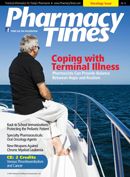Publication
Article
Pharmacy Times
Outlook: Obesity

Voicing unanimous support for healthier school lunches, the US Senate passed new legislation that aims to oust junk food from the nation’s school cafeterias and replace it with nutritionally balanced fare. Approved on August 5, 2010, the Senate’s Healthy, Hunger-Free Kids Act of 2010 will invest $4.5 billion in programs to help schools accomplish that goal over the next 10 years.
The legislation increases reimbursements for school lunches by an additional 6 cents per meal, which will go toward purchasing healthier ingredients to meet new nutritional standards. Other provisions are included to eliminate the sale of sugary snacks and beverages to students and support the integration of farm-toschool programs.
The bill also improves access to free meal programs by expanding eligibility requirements; reducing paperwork required to enroll low-income children; and distributing more meals to at-risk children before school, after school, and during the summer months. The House is expected to vote on its version of the bill in mid- September. For more information, visit ag.senate.gov/site/legislation.html.
Adult Obesity On the Rise
The number of obese adults in the United States has risen by 2.4 million, or 1.1%, since 2007, according to the Centers for Disease Control and Prevention (CDC)’s CDC Vital Signs report. The number of states with an obesity prevalence of 30% or more has tripled to 9 states in the past 2 years.
In addition, no state has achieved an obesity prevalence of 15% or lower—a national objective outlined in the government’s Healthy People 2010 agenda. Medical costs for obese people were approximately $1429 higher than those of normal weight, the report noted.
The problem extends beyond personal responsibility, according to William Dietz, MD, PhD, director of the CDC’s Division of Nutrition, Physical Activity, and Obesity. “People in all communities should be able to make healthy choices, but in order to make those choices there must be healthy choices to make,” Dr. Dietz said. “We need to change our communities into places where healthy eating and active living are the easiest path.” For more information on adult obesity, visit www.cdc.gov/vitalsigns/adultobesity.
Dorms With Cafeterias Promote “Freshman 15”
Freshman-year weight gain may be even more difficult to avoid when students have access to a cafeteria in the same building where they sleep, study, and socialize, the results of a new study show.
Based on their analysis of self-reported data from college students, researchers from the University of Michigan’s Institute for Social Research found that physical environment, such as proximity to a gym or dining hall, strongly influenced behavior regarding food choices and exercise. Women in dormitories with cafeterias reported weighing almost 2 pounds more and exercising less frequently. Men in the same dormitories were more likely to indulge in frequent meals and snacks.
Lest the findings inspire resignation to the inevitability of the “Freshmen 15,” the researchers noted that the influence swings both ways: women who lived near a campus gym exercised more often than those who did not. The results were published August 3, 2010, in the online issue of the Journal of Adolescent Health.
Designing Better Weight Loss Interventions
Obese adults are more receptive to weight loss programs that focus on lifestyle changes, rather than a number on the scale, according to research published in the July issue of BMC Public Health. The findings suggest a holistic approach to obesity treatment and counseling may be a more successful way to help patients lose weight and improve their health.
The qualitative study surveyed 142 obese Australian adults to examine their opinions toward a variety of large-scale and individualized health interventions— from national media campaigns to commercial dieting programs, such as Weight Watchers. Of all the approaches, participants were most averse to media campaigns; only 33% believe they are an effective way to reduce obesity.
Researchers cited a “Reduce Your Waist” media campaign by Australia’s Cancer Council, which linked obesity to certain cancers, and was perceived by many to be “too negative.” In interviews, participants said such campaigns only added to the stigma of being overweight, without constructively helping obese individuals develop strategies for behavioral change. “There’s a fine line between trying to scare people to death and actually encouraging them,” one respondent said.
The most positively received intervention focused on specialized fitness programs. A total of 57% said fitness programs provided the support necessary to improve health and well-being. In particular, participants expressed the need for a “safe space” for exercise, in which they felt “emotionally secure and supported.” Government regulations designed to promote healthy behaviors—such as banning junk food advertising and improving school lunches— also earned support.
“At the individual level, personalized care planning and long term support systems must be developed to assist obese individuals,” the report concluded. “At the population level, anti-stigma campaigns and regulation should both be explored.”







